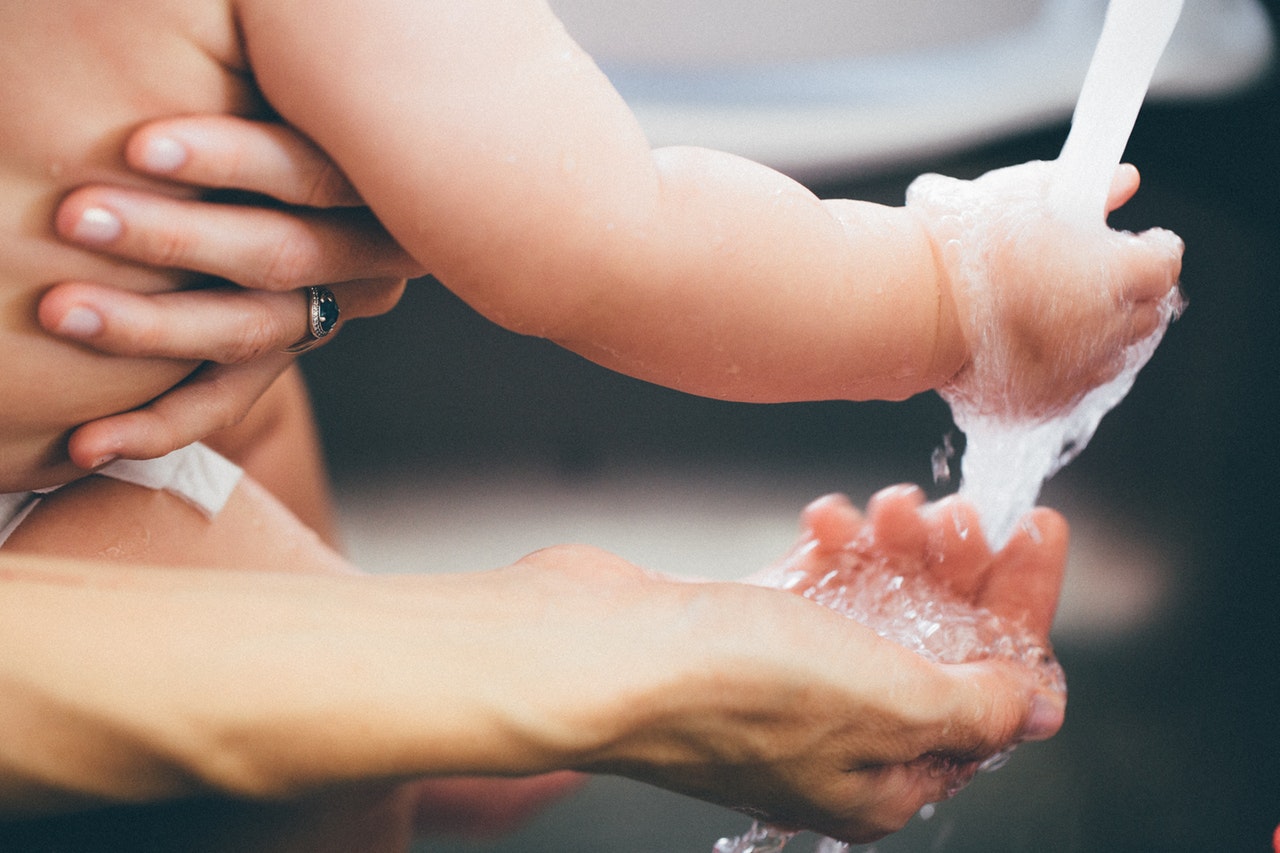Grandmom’s Wisdom – Hygiene for Health, Handwashing for the Win
“Take your fingers out of your mouth,” she said. “Don’t bite your nails,” she said. “Wash your hands!” she said. About this, and so many other things, my grandmother had it right.

My grandmother, an excellent cook, meticulous house-keeper, and passionate feeder, held great power in her hands: the power to soothe my stomach aches and cut my bangs and create miracles out of a few simple ingredients. The woman who hand-knitted sweaters (for me and my doll,) who laid dough made from scratch across the floured surface of her kitchen table for kreplach, who filled her basement freezer with soups, brownies, and entire frosted cakes, all made in her own kitchen, with her own hands – she knew the value of passing on her wisdom and ways by example. She also wasn’t shy about advocating for very deeply-rooted aspects of her belief system via a consistently repeated refrain. One of her oft-reiterated points: make sure your hands are clean. You didn’t have a prayer of getting to lick beaters dripping with brownie batter or helping to roll the schnecken if you didn’t wash your hands.
While I wasn’t a great hand-washer growing up, some trigger flipped as I got older (maturity? anxiety?) and I became acutely aware of the ways we use our hands in the world and how we transmit materials of all kinds via touch, exploration, and the simple act of coexisting in a society of fellow humans. Every surface we contact with a hand or a finger leaves our imprint upon it, even as we take away the invisible leavings of whomever came before us. Every interaction with the world is an opportunity to transfer unknown materials to others, to carry the same unknowns into our lives on our skin, to invite pathogens to travel from our hands to the mucous membranes of the eyes, nose, and mouth. As I casually rest my hand on a coffeehouse table, what am I communicating from the wood onto my palm? And as I enjoy my coffee, what do I observe in the public space around me? There, a Gen Z’er absently stroking the sole of her sneaker as she studies. What was on the ground as she walked that winds up on her computer keyboard, and where will it go from there? There, a toddler with an entire fist in his mouth. And over there, a woman who a moment before emerged from the restroom, wets the tip of her finger with her tongue to gather the last of the croissant crumbs from her plate. And I wonder, did she use a sanitary procedure to wash, dry, and leave the loo without recontaminating her hands?
The danger and disgust of poor hygiene habits is current in the news. Humans survived for millenia without running water, and regular hand-washing has been with us for less than two hundred years. But as humanity socialized and began to live in closer proximity, we repeatedly lost huge portions of our population to the human-to-human spread of disease. Even now, with the advent of vaccinations, sanitation, and regulated health ordinances, the fact remains that living in community means a constant exchange of contact, and with that, contact with chemical compounds, pathogens, allergens, human DNA, and just plain dirt.
It’s also true that most of what we touch will be harmless, processed by the body and the immune system with little to no effect. And while many of us move through the world unconsciously opening doors and shaking hands, then rubbing an eye or nipping the mustard off a thumb during a grab-and-go lunch without ever thinking twice, the truth is, flu season or not, coronavirus or not, the CDC and WHO agree: Grandmom was right. Washing our hands consistently and well is the single best way to prevent the spread of disease. And another point about hand-washing Grandmom cared about deeply? It’s just good manners.
To keep a family safe, healthy, and well, as my grandmother worked so very hard to do, practice good hygiene designed to reduce your exposure to pathogens. Wise at all times, but especially when viruses are on the rise, follow these tips:
Washing Up – How
Most of us have seen the “how to wash” procedure by now. Despite that, most of what you can observe in public restrooms fails to come close to accepted best practices. At home and especially in public, washing the correct way and for the right length of time is key to accomplishing the point: getting clean! It’s definitely not easy to make the process stick for little kids (or, let’s be real, all kids) but staying healthy is worth the effort!
- Wet your hands to the wrists with clean, running water of any temperature.
- Apply soap and lather by rubbing your hands together. Lather to the wrists, including the backs of your hands, between your fingers, and under your nails.
- Scrub for at least twenty seconds. Hum the “Happy Birthday” song from beginning to end twice, or sing the alphabet song!
- Rinse your hands well under clean, running water.
- If in a public restroom, use a paper towel to turn off the water. If none are available, use your elbow to close the faucet. (Pro tip – Carry a few paper towels or a small hand towel in your bag!)
- Dry your hands using a clean towel. Air dryers in public restrooms are notorious pathogen-spreaders, so avoid them whenever possible.
- When exiting a public restroom, use a clean paper towel to open the door if necessary. If none are available, use a sleeve, or the hem of a jacket or skirt.

Washing Up – When
When to wash our hands seems obvious, but the actuality of our practice leaves lots to be desired. In the interest of keeping it clean, always wash your hands:
- Upon arriving home from anywhere, especially a public place.
- Before eating.
- Before food preparation.
- After handling meat or eggs.
- After using the bathroom, helping a child in the bathroom, or changing a diaper.
- After blowing your nose, coughing, or sneezing.
- After handling dirty laundry, and before handling clean laundry.
- After and during house cleaning.
- After washing dishes.
- After handling or taking out trash.
- After doing yard work.
- Before and after caring for anyone ill.
- Before and after treating a cut or wound.
- After touching an animal, animal food, or animal waste.
- After clipping fingernails or toenails.
- After handling shoes.
When in Public
When you’re out and about, keeping your hands clean is tough to navigate, especially with children who want to inspect and pick up everything they see, not to mention crawl around on the ground. Being in public does offer good teachable moments that (fingers crossed!) kids can carry with them to school and when at play. When in public, try to:
- Avoid touching your face, especially your eyes, nose, or mouth.
- Avoid touching door handles, bannisters, and other often-touched surfaces when possible.
- Replace hand-shaking with a slight nod or bow, a friendly wave, or even a fist-bump if appropriate!
- When using a public restroom, use your foot to flush instead of your hand.
- Carry hand-sanitizer for occasions when hand-washing isn’t an option, and use it after being in populated spaces like train stations, grocery stores, even an Uber.
- If you’re eating on the go and can’t wash your hands, use hand sanitizer, and use utensils or the wrapper of your to-go food to avoid touching it whenever possible.
Home Practices
Aside from hand-washing and keeping your person-to-person physical contact to a minimum when in public, there are precautions you can take to avoid bringing outside pathogens and other materials home and keep your risk levels low.
- Consider being a “shoes off” household (yes, you will be those people) especially in homes with babies and toddlers.
- Use a disinfecting wipe to clean down your phone upon arriving home, every time, then wash your hands.
- Use a disinfecting wipe to clean your laptop too, whenever you take it out.
- Keep the surfaces in your home as clean as possible, especially if someone is ill.
- Public door handles aren’t the only ones that breed germiness; disinfect door knobs and handles in your own home regularly.
General Health and Hygiene Wins
There’s a lot we can do to foster our own baseline of wellness, so that if and when we do get sick, we’re able to recover more quickly, plus help care for family members to whom we may have passed our illness. And as we care for ourselves, we can’t forget to keep an eye out for the community we live in. Good hygiene benefits all. To the best of your ability:
- Use and teach children good cough and sneeze etiquette to cut down on the spread of the miniscule droplets that spread pathogens via air and surfaces. Always aim a cough or sneeze into the crook of your elbow, never into your hand!
- If you feel you’re coming down with something, and when kids seem unwell, stay home whenever possible. If you must go out, keep aware of your contact with others, and with public surfaces.
- Help your family maintain a nutrient-rich diet and avoid immune-crashers like sugar and processed foods.
- Get regular exercise.
- Try for seven or eight hours of sleep a night, and more for children and teenagers!
In the end, we do know it’s impossible to avoid getting sick now and again, but these easy tips and lifestyle changes can help keep the risk down for you and the community you live in. And if you do come down with something? I hope you have somebody as loving, compassionate, and wise as my grandmother to help you get back on your feet.






Debralynn Murdock March 6, 2020
I also grew up with the wisdom of an amazing grandmother who shared the importance of hygiene in all things.
Your article is spot on!
Karen Barbuscia March 6, 2020
There’s nothing like a grandmother! Thank you, Debralynn!